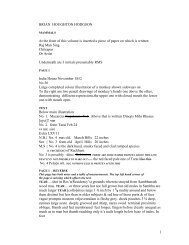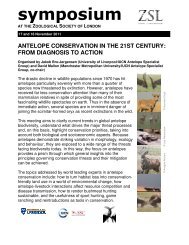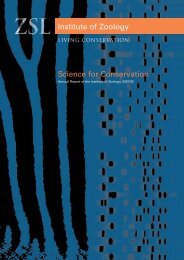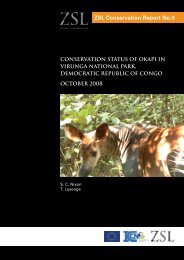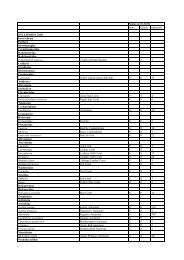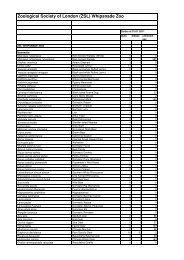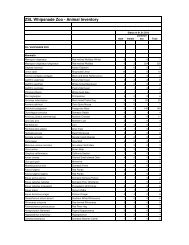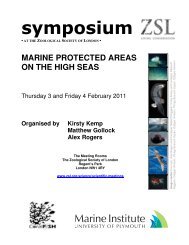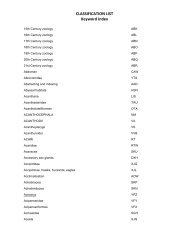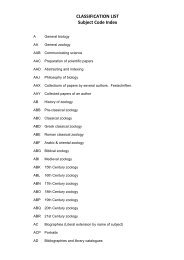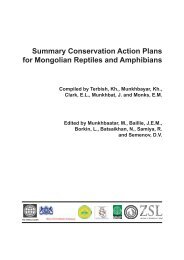Mongolian Red List of Reptiles and Amphibians - Web - Zoological ...
Mongolian Red List of Reptiles and Amphibians - Web - Zoological ...
Mongolian Red List of Reptiles and Amphibians - Web - Zoological ...
You also want an ePaper? Increase the reach of your titles
YUMPU automatically turns print PDFs into web optimized ePapers that Google loves.
Global distribution: Russian Federation; Kazakhstan;<br />
China; Mongolia; Democratic People’s Republic <strong>of</strong><br />
Korea; Japan (IUCN, Conservation International, <strong>and</strong><br />
NatureServe, 2006; IUCN, 2007). Possesses the widest<br />
geographical range <strong>of</strong> any recent amphibian species,<br />
spanning approximately 12 million km 2 globally (IUCN,<br />
Conservation International, <strong>and</strong> NatureServe, 2006).<br />
Regional distribution: Coniferous forest <strong>and</strong> steppe<br />
habitats associated with freshwater sources in northern<br />
Mongolia. Distribution includes Hövsgöl Lake, the<br />
Hentii Mountain Range along Bogd <strong>and</strong> Tuul rivers, northern Bayanzurkh, Huder, Shaamar<br />
<strong>and</strong> Zuunburen along Orkhon <strong>and</strong> Selenge rivers, Hongor Tolgoi along the Eg River, Darkhad<br />
Depression along Shishhed River, <strong>and</strong> in Tes <strong>and</strong> Onon rivers (Munkhbayar <strong>and</strong> Terbish,<br />
1997; Terbish, et al., 2006). This species is distributed in Selenge, Orkhon, Tuul, <strong>and</strong> along<br />
associated rivers including Shishkhed, Ukhert, Arsai, Khug, Guna, <strong>and</strong> Tengis in Khoridol<br />
Saridag, Ulaan taiga mountain <strong>and</strong> the Arctic drainage basin (Munkhbayar, 1976b; Kuzimin<br />
et al., 1986; Ulykpan <strong>and</strong> Munkhbayar, 1982; Litvinov <strong>and</strong> Skuratov, 1986; Terbish et al.,<br />
2006). The species is also distributed in the Onon river basin in the Hentii Mountain Range<br />
(Munkhbaatar <strong>and</strong> Ariunbold, 2001), the upper part <strong>of</strong> Herlen River (Hotolkhuu, 1969),<br />
<strong>and</strong> Tes river which runs from the Hangai Mountain Range to Uvs Lake <strong>of</strong> the Great Lake<br />
Depression (Davaa et al., 1990; Terbish et al., 2006). It occurs at elevations <strong>of</strong> 600-2,250<br />
metres above sea level in Mongolia (Borkin <strong>and</strong> Kuzmin, 1988), <strong>and</strong> has been recorded<br />
at elevations <strong>of</strong> 2,200 metres in alpine habitats on the southern slopes <strong>of</strong> Munkhsaridag<br />
Mountain along the Arig River (Litvinov, 1981; Litvinov <strong>and</strong> Skuratov, 1986). This species<br />
has an estimated extent <strong>of</strong> occurrence <strong>of</strong> around 202,083 km 2 .<br />
Dominant threats: Habitat degradation <strong>and</strong> loss, primarily caused by marsh drainage <strong>and</strong><br />
water pollution (Munkhbayar <strong>and</strong> Terbish, 1997). Water pollution is a particular problem<br />
around Ulaanbaatar <strong>and</strong> Shaamar in Mongol Daguur Steppe, <strong>and</strong> is evident along the Tuul<br />
river <strong>and</strong> Uu bulan, caused by sewage release, domestic, industrial <strong>and</strong> agricultural waste.<br />
Other causes <strong>of</strong> habitat degradation, fragmentation <strong>and</strong> loss include resource extraction<br />
(gold mining <strong>and</strong> logging), establishment <strong>of</strong> human settlements, <strong>and</strong> wildfi res (particularly<br />
in coniferous forest habitats). Intrinsic factors such as limited dispersal, low densities <strong>and</strong><br />
restricted range make this species vulnerable to stochastic events. Drying <strong>of</strong> water sources<br />
<strong>and</strong> droughts threaten this species, although it remains unclear if these represent natural<br />
environmental changes or are driven by anthropogenic activity. Parasites are also a problem;<br />
the lungs <strong>of</strong> a one-year-old Siberian salam<strong>and</strong>er found in Shaamar were infected with a<br />
species <strong>of</strong> nematode (Rhabdias spp.) (Munkhbayar <strong>and</strong> Terbish, 1997).<br />
28



